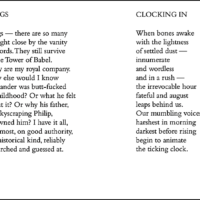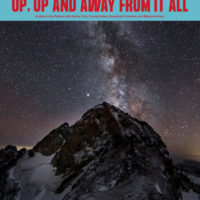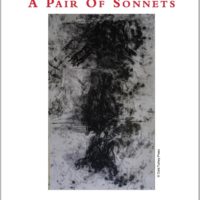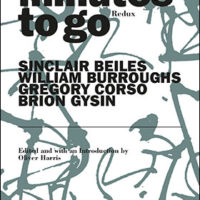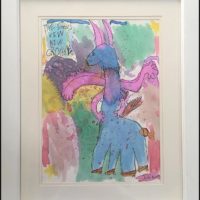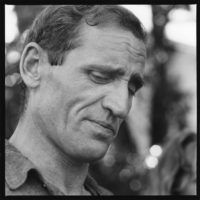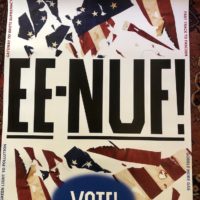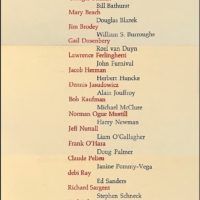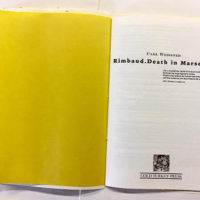My sonnets don’t usually come in pairs, although looking back on them I can see them being paired sometimes as sequels or cousins. Paradoxically, these two came as a pair because they are so different from each other. The darker mood of the one that came second (“Clocking In”) rebukes the lighter mood of the one that came first (“Kings”). Why I should have objected puzzles me now.
From the Design Department
Cutting Edge: Up, Up and Away Off the Page
The designers of The New York Times Magazine are at it again. Do they think edgy makes sense when their design looks like the cover was badly trimmed? Yes, the headline reads “UP, UP AND AWAY FROM IT ALL.” But if the rationale for the design was to get so far up and away, why take half measures? Why not clip off the name of the magazine entirely? Now have a look at the off-the-page design of the spread complete with layout markups, which introduces the cover story on page 43. My guess is the editors want to persuade us the magazine is spontaneous and improvisatory (as in no longer the Gray Lady of legend, which it actually hasn’t been for many years).The spread works nicely. Much better than the cover. But why are they trying so hard?
Good Question: ‘Who’s Your Death Hero?’
Although Albert Camus does not come up in WHO’S YOUR DEATH HERO? — a conversation between the filmmaker Richard Kern and the writer who goes by the name of Supervert — he would be my candidate in answer to the title. Camus’s declaration, “I want to keep my lucidity to the last and gaze upon my death with all the fullness of my jealousy and horror,” conveys precisely what this book is about as if he’d read it himself.
Cold Turkey Press: ‘A Pair of Sonnets’
‘Both belong to a cycle of nine, mostly written during my stay in the rural Connecticut countryside to escape the Covid-19 pandemic during the Spring and Summer of 2020. Both are addressed to writers I admire. “Last Breath” begins the cycle. It was written while remembering my late friend Carl Weissner, before the pandemic began. “The Way the Lines Break” ends the cycle. It was written toward the end of my stay and is addressed to Théophile Gautier, whose poems and stories I was reading thanks to the suggestion of my friend Gerard Bellaart.’ — JH
Fascinating Passages from Fascinating Books
‘Really, poems by William Burroughs? Yes indeed, and what we know as The Cut-Up Method he initially called ‘Newspeak Poetry,’ making clear his original frames of reference.’ — MINUTES TO GO Redux
A Sweet Child’s Vision . . .
. . . not long before covid makes me think of Chagall.
‘The Greatest Piece of Writing’ Kerouac Ever Saw
It’s a 16,000-word letter that Neal Cassady wrote to Jack Kerouac, who said it was his inspiration for On The Road. The letter, written in 1950, went missing and was found in an attic in Oakland, California, in 2011. Now for the first time it is being brought out in full by the London-based publisher Black Spring with an introduction by the noted Beat scholar A. Robert Lee, along with illustrations. I’m betting Lee will tell us if the letter really was the inspiration for On the Road—Kerouac, true to his calling, loved to make things up— and if he really did adopt his prose style from it. The reality is likely more nuanced than the legend.
Artist Ed Ruscha Dumps on Fossil-Fueled Trump & Co.
Ed Ruscha‘s latest poster “EE-NUF! VOTE!” offers this commentary: “Get Richer” / “Bye-Bye Roe Vs. Wade” / “Highway to Hell” / “Fast Track to Facism” / “Gobble More Gas” / “Kids in Cages” / “EE-NUF EE-NUF” / “You’ve Got the Most to Lose” / “Green Light Pollution” / “Gateway to White Supremacy”
Van Dyek Parks tweeted the poster today with this comment: “We will weave civility into the torn fabric of our flag—-with illuminations from the arts—by the likes of So-Cal’s adopted son Ed Ruscha.”
This Kind of Journalism Helps Make a Newspaper Great
‘Until recently, many Americans had never heard of the Tulsa Race Massacre.’ From The New York Times: ‘A Search for Hallowed Ground.’ Photographs by Joseph Rushmore and Gary Mason. Text by Campbell Robertson.
Booted!
This is what the people did back then: Infamous William M. Tweed, the corrupt 19th-century NYC power broker whose ring of cronies controlled the government purse, manipulated the legislature, and embezzled hundreds of millions of dollars, was booted from office in the election of Nov. 7, 1871. Thomas Nast depicted him in defeat as a bloated, gouty Roman consul clutching a broken sword, wearing a royal headband of threadbare dollar signs and a sovereign medallion off his miserable likeness on his fat belly. Fast forward to Nov. 7, 2020.
Outside the Walls: ‘Being Free’
For more than 50 years Ben Vautier has worked “outside the walls,” embracing daily life in its multitude of contradictions. Now, in “Being Free,” an exhibition opening July 11 and running through October 11 in Chamarande, France (about 50 minutes south of Paris), he brings together more than 400 works which document his prodigious output.
Is It a Moon Shot? Nope, It’s a Book Chat.
Follow the countdown—the days, hours, minutes, and yes, even the seconds—to Blake Gopnik’s chat with Annalyn Swan about his biography of Andy Warhol. Well, it IS a big book. Big in page count (976). Big in subject (Warhol’s influence rivals Picasso’s.) Stellar in praise. (I’ve read only one review that dumps on it, persuasively.) So okay, a countdown.
A San Francisco Little Mag Subscription-cum-Ad-Rate Card
This is what one looked like in the old days—1968 to be precise—and have a look at those prices. Then check out the contributors.
Can the Internet Do This? Nope.
Folio as ‘objet d’art’: “Death in Marseille” by Carl Weissner. Translated and edited from the German by Keith Seward & Jan Herman. Designed and printed by Gerard Bellaart on Handmade Barcham’s Greenpaper. Trim size: 328×220 mm. Edition limited to 12 copies.
Collage by Late Cubist, Age 8, Bored in Lockdown
Boredom sometimes works wonders . . . with teacher’s help.
Latest Find Thrills Collector of Rare Burroughs/Gysin Books
Jeff Ball’s latest acquisition—a first-edition copy of “The Exterminator”— is not only signed by both William Burroughs and Brion Gysin but has original artwork that Gysin drew and signed on an inside page. “I’m giddy!” says Ball, whose collection of rare first editions by Burroughs and associated writers, includes some of the most hard-to-find materials anywhere.
GC CUNY Keeps the Conversation Going:
LGBTQ Pride Month Conversation with Patrisse Cullors, co-founder of Black Lives Matter
Artist, organizer, and co-founder of Black Lives Matter, Patrisse Cullors is the co-author of the best seller “When They Call You a Terrorist: A Black Lives Matter Memoir.” At the age of 16, Cullors discovered her passion for helping young queer women facing the challenges of poverty, prejudice, and violence. In 2013, she co-founded the #BlackLivesMatter movement, which has grown into an international organization fighting anti-Black racism. She spoke with Justin T. Brown, executive director of CLAGS: The Center for LGBTQ Studies.

